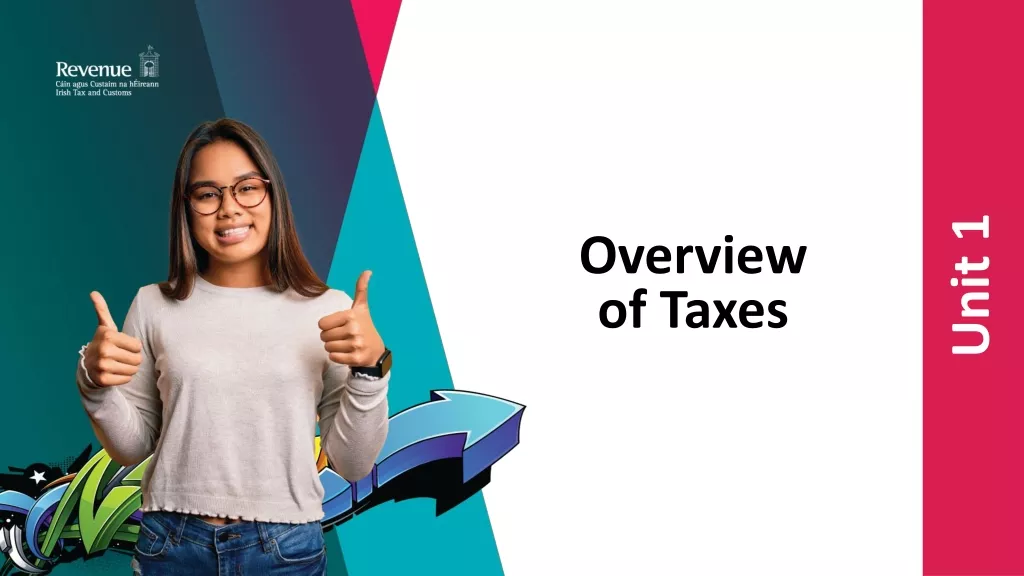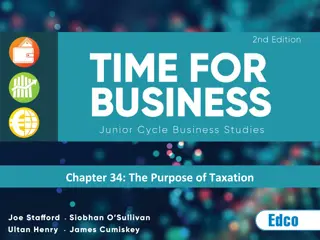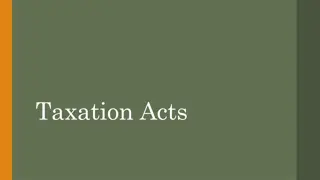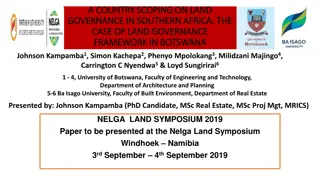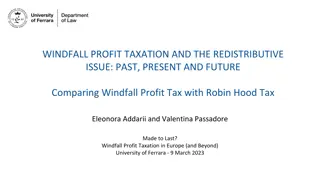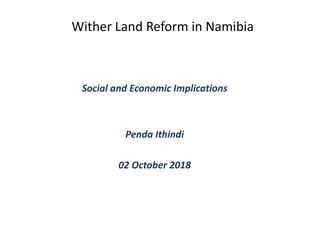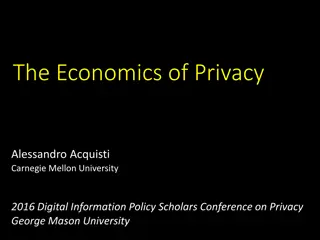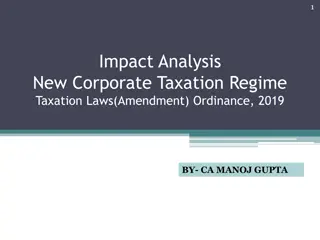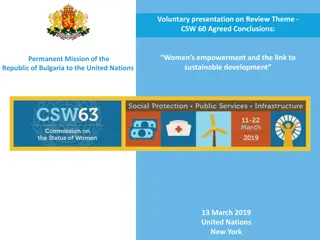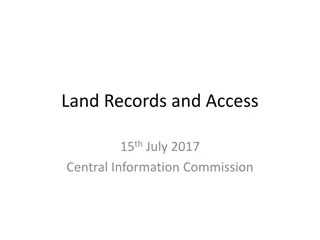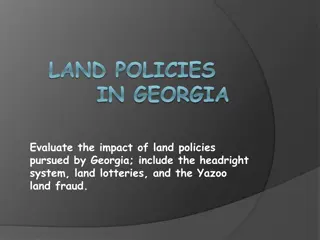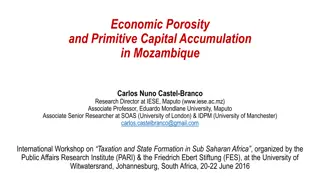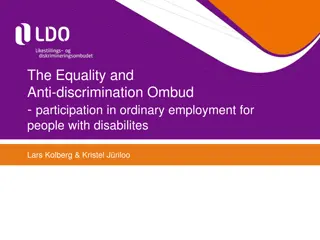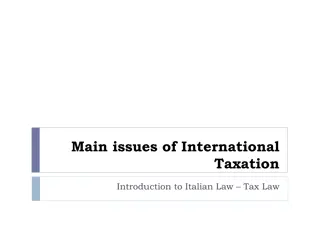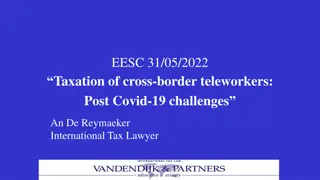Reviving Georgism: Redistributive Land Taxation for Economic Equality
Explore the concept of Georgism advocating for redistributive land taxation to address economic inequalities through property taxes on land. Discover how this approach could fund basic income, optimize public finance, and benefit society. Insights from influential economists like Henry George, Milton Friedman, Arnott, and Stiglitz shed light on the potential benefits of implementing a land value tax system.
Download Presentation

Please find below an Image/Link to download the presentation.
The content on the website is provided AS IS for your information and personal use only. It may not be sold, licensed, or shared on other websites without obtaining consent from the author.If you encounter any issues during the download, it is possible that the publisher has removed the file from their server.
You are allowed to download the files provided on this website for personal or commercial use, subject to the condition that they are used lawfully. All files are the property of their respective owners.
The content on the website is provided AS IS for your information and personal use only. It may not be sold, licensed, or shared on other websites without obtaining consent from the author.
E N D
Presentation Transcript
Redistributive land taxation Alain Trannoy Canazei Winter school January 2017
Modern public economics When we think nowadays about redistributive taxation Progressive income tax Capital tax, inheritance tax Land is back (Leuven April 2016) 2
Georgism Single tax movement: Henry George is best known for his argument that the economic rent of land (location) should be shared by society George proposed to create a pension and disability system, and an unconditional basic income from surplus land rents. It would be distributed to residents "as a right" instead of as charity. Georgists often refer to this policy as a citizen s dividend in reference to a similar proposal by Thomas Paine Land is back (Leuven April 2016) Bonnet, Bono, Chapelle, Trannoy, Wasmer 3
Letter to Gorbatchev November 7, 1990 Mikhail Gorbachev, President Union of Soviet Socialist Republics Dear Mr. Gorbachev: The movement of the Soviet Union to a market economy will greatly enhance the prosperity of your citizens. Your economists have learned much from the experience of nations with economies based in varying degrees on free markets It is important that the rent of land be retained as a source of government revenue. While the governments of developed nations with market economies collect some of the rent of land in taxes, they do not collect nearly as much as they could, and they therefore make unnecessarily great use of taxes that impede their economies--taxes on such things as incomes, sales and the value of capital. Land is back (Leuven April 2016) Bonnet, Bono, Chapelle, Trannoy, Wasmer 4
30 economists among whom William Vickrey, Jacques Thisse, Tibor Scitovsky, James Tobin, Richard Musgrave, Franco Modigliani, Zvi Griliches, William Baumol, Robert Solow In my opinion, the least bad tax is the property tax on the unimproved value of land, the Henry George argument of many, many years ago. Milton Friedman Land is back (Leuven April 2016) 5
Henry Georges Theorem Arnott and Stiglitz (1979) Under some conditions, it is optimal to finance local public infrastructures and utilities with a tax on rents or tax on real estate Different perspective, not local public finance, but nationwide public finance. Land is back (Leuven April 2016) 6
Outline 1. Why a revival of Georgism? 2. Is it possible to fund a basic income with a property tax on land which correct both inequalities in ownership of land and capital? 3. In the likely case where the level of tax rate on the real estate cannot be politically accepted by landowners, is a tax on rents (without including imputed rents) second best? 4. The actual world is quite different from that of Henry George with the emergence of a vast middle class which becomes homeowner when people are sufficiently old. Should the property tax also be borne by the old middle class ? Land is back (Leuven April 2016) 7
Based on forthcoming WP Land is back and it must be taxed Odran Bonnet, Guillaume Chapelle, Alain Trannoy, Etienne Wasmer Land is back (Leuven April 2016) 8
1. Aftermath of Pikettys book The impetus: Capital in the twenty-First Century Piketty did three things: 1. From an empirical view point: new series about ?/? 2. From a theoretical view point: exploding accumulation of capital and linkage with growing inequality 3. From a policy view point: a world tax on capital Land is back (Leuven April 2016) Bonnet, Bono, Chapelle, Trannoy, Wasmer 9
Housing land: main source of divergence of K/Y (France) Land is back (Leuven April 2016) Bonnet, Bono, Chapelle, Trannoy, Wasmer 10
Housing price indices Land is back (Leuven April 2016) Bonnet, Bono, Chapelle, Trannoy, Wasmer 11
Residential-structure price indices Land is back (Leuven April 2016) Bonnet, Bono, Chapelle, Trannoy, Wasmer 12
Housing Land prices indices Land is back (Leuven April 2016) Bonnet, Bono, Chapelle, Trannoy, Wasmer 13
Share of land in housing capital Land is back (Leuven April 2016) Bonnet, Bono, Chapelle, Trannoy, Wasmer 14
Why increasing housing land prices/income ratio ? 1. Credit 2. Population growth 3. Land regulation Land is back (Leuven April 2016) Bonnet, Bono, Chapelle, Trannoy, Wasmer 15
Credit exuberance (Robert Shiller) Credit exuberance during the beginning of this millenium. Lower interest rates Longer mortgage maturity Lower downpayment or higher loan-to-value ratio Higher cap for debt-to-income ratio Land is back (Leuven April 2016) Bonnet, Bono, Chapelle, Trannoy, Wasmer 16
Credit exuberance France: Mortgage-to-downpayment ratio for existing properties: first-time owners, other owners 4.00 3.50 3.00 2.50 2.00 1.50 1.00 0.50 0.00 1985 1990 1995 2000 2005 2010 2015 Land is back (Leuven April 2016) Bonnet, Bono, Chapelle, Trannoy, Wasmer 17
Real causes Growth of population The value and thus economic rent of land, which is permanently inelastic in supply, is governed by the growth in demand for land for purposes of food production and housing, which in turn is driven by population growth. The increasing value and rent is, in the Ricardo-George context, entirely due to the growth of population Warren Samuel You don t need sunspots to trigger a housing land bubble Land is back (Leuven April 2016) Bonnet, Bono, Chapelle, Trannoy, Wasmer 18
Housing land regulation Three different periods for France 1955-1975 : the influence of Le Corbusier Social housing and large housing estates Relatively land use saving 1975-1995 : Middle class left large housing estates for new houses in suburbs. Urban sprawn, land use augmenting 1995- : Greenness more respectful of agricultural land and recreative areas. Restrictive zoning Local political equilibrium (because it will increase the price of housing land for already homeownert) Land is back (Leuven April 2016) Bonnet, Chapelle, Trannoy, Wasmer 19
Paris Le Corbusier 1937 Land is back (Leuven April 2016) Bonnet, Bono, Chapelle, Trannoy, Wasmer 20
Credit maybe not the original cause Suppose that bankers are smart. They remember the Ricardo-George result for countries with growing population or shift to smaller household size They expect land regulation to be a political equilibrium They deduce that on the long run the value of the mortgage collateral will be pushed up. They will be very friendly when new mortgages are asked. Credit lines up with the fundamentals And people are just bayesians with respect to the evolution of housing land prices. Land is back (Leuven April 2016) Bonnet, Bono, Chapelle, Trannoy, Wasmer 21
Our reading of Piketty Empirical side 1. The evolution of ?/? is mainly governed by housing 2. The evolution of the market value of housing is mainly driven by land price for both real, policy and financial reasons Policy side Suppose that we can tax housing land separately from structures. (Example of Pittsburgh of two rates or Split-rates from 1913 to 1979-1980) see Oates and Wallace 1997 NTJ) Land is back (Leuven April 2016) Bonnet, Chapelle, Trannoy, Wasmer 22
2. Macroeconomic foundation of Neogeorgism Is it possible to fund a basic income with a property tax on land which correct both inequalities in ownership of land and capital? Judd s model (close but a bit different from Chamley) Land is back (Leuven April 2016) Bonnet, Bono, Chapelle, Trannoy, Wasmer 23
Judds model Two types of agents, one type of capital, one aggregate consumption good Capitalists optimally choose capital and intertemporally allocate consumption ??, and capital investment ?? Workers consume their wages ??= ?? Capital taxation is not first best, and not even second best. Judd = Negative Ramsey result. Still some mathematical pbs (Straub & Werning (2015)) Land is back (Leuven April 2016) Bonnet, Bono, Chapelle, Trannoy, Wasmer 24
Extension to land use and property Two classes: capitalists and landlords vs workers and tenants. Benchmark: Housing = Land housing The capitalists own all land ? For their housing use, ??, and they rent the remaining to workers ? Purely redistributive aim of taxation to redistribute welfare from capitalists to workers. (No public expenditure) Link with equality of opportunity Bonnet, Bono, Chapelle, Trannoy, Wasmer Land is back (Leuven April 2016) 25
Model (I) Capital investment equation: ??+1= ??1 ? + ?? Utility of capitalists-landowners: ???(??,??) ?=0 Utility of workers-tenants: ???(??, ?) ?=0 Land is back (Leuven April 2016) Bonnet, Bono, Chapelle, Trannoy, Wasmer 26
Model (2) Ressource constraint of the economy: ??+ ??+ ??+1 ? ?? + 1 ? ?? Factor s returns: ??= ? ?? ? ???? ?? Tax on capital: ????????,? ??????= ? ?? + 1 ? ?????? ????= (1 ????????,?)?? Net return on capital :?? Tax rate of the rent:?????,? Land is back (Leuven April 2016) Bonnet, Bono, Chapelle, Trannoy, Wasmer 27
Capitalists/landlords program Maximisation program: ???(??,??) Max ??,??,??+1 ?=0 ??????1 ????????,???+ ?? ??????(1 ?????,?)( ? ??) ?.?. ??+ ??+1= ?? Euler equation: ??????1 ????????,??? ??,?? = ???+1 (??+1,??+1) ?? Intra-period allocation: ??????1 ?????,??? ??,?? = ?? (??,??) ?? (??,??) 0 Transversality condition: ?t?? Land is back (Leuven April 2016) Bonnet, Bono, Chapelle, Trannoy, Wasmer 28
Workers/tenants program Worker does not save. Live in units of rented housing and consume from their wage and of a government transfer ? Maximization program: ???(??, ?) Max ??, ? ?=0 ??????= ??+ ?? ?.?. ??+ ??? First order condition: ???????? ??, ? = ?? ??, ? ? Land is back (Leuven April 2016) Bonnet, Bono, Chapelle, Trannoy, Wasmer 29
First best setting The Gvt is able to commit to future tax policies In a model without land, we already know that the first best can be implemented through constant tax on consumption for all periods (Coleman (2000) JpubE) or tax on capital with tax credit on new capital = tax rate (Abel (2007 JPubE) Way to tax initial capital No restrictions on instruments Tax on land Tax on rents including imputed rents Land is back (Leuven April 2016) Bonnet, Bono, Chapelle, Trannoy, Wasmer 30
Program of the social planner ??? ??, ? ?? + ??(??,??) ??,??,??,??+1 Max ?=0 ??+ ??+ ??+1= ? ?? + 1 ? ?? ?.?. ?? ?(??,??) = ? ?(??, ? -?? ) = ? ?? ?(??,??) = ? (??, ? -?? ) ?/ ?+1= ?(? ??+1 + 1 ?)) 1 ? At the steady state: ???????= Land is back (Leuven April 2016) Bonnet, Bono, Chapelle, Trannoy, Wasmer 31
First-best taxation Results A tax on land or a tax on rents including imputed rents decentralizes the first best Taxation of capital or rents are not first-best optimal Land is back (Leuven April 2016) Bonnet, Bono, Chapelle, Trannoy, Wasmer 32
3. Second best setting The set of available distortionary tax instruments is given and the optimal tax system within this set is explored Not possible to confiscate initial capital Three constraints on land tax instruments No land register Only 50 countries have one (over 200) (Van der Molen et Al 2014) The most hated tax: in the US (Cabral-Hoxby (2012)), among the Swedes (Hammar and al.(2008)) Cap on the property tax as in California proposition 13 (June 6, 1978). Not possible any more to tax imputed rent Likely because ownership becomes widespread (up to 1963 in France) Land is back (Leuven April 2016) Bonnet, Bono, Chapelle, Trannoy, Wasmer 33
Ramsey problem Tax on new capital vs tax on housing rents Gvt finances redistribution by a flat tax either on rents or capital Maximize social welfare under constraints Resource constraint of the economy for each period FOCs of the capitalist (Euler, intraperiod allocation between consumption and housing, transversality) FOC of the worker Land is back (Leuven April 2016) Bonnet, Bono, Chapelle, Trannoy, Wasmer 34
Without Housing: Planner Program ??? ?? + ??(??) Max ??,??,??+1 ?=0 ??+ ??+ ??+1= ? ?? + 1 ? ?? Mutiplier ? ?? ?? ??+ ??+1 ? ?? 1?? Mutiplier ? ??? ????+1 0 Land is back (Leuven April 2016) Bonnet, Bono, Chapelle, Trannoy, Wasmer 35
Statement of Judds result (Version of Straub & Werning (2015) Theorem: Suppose quantities and multipliers converge to an interior steady state, i-e, ??, ??, ??converge to positive values and ??converges. Then the tax on capital is zero in the limit. Land is back (Leuven April 2016) Bonnet, Bono, Chapelle, Trannoy, Wasmer 36
Completing Judds statement We define ?? (?) ? (?) ? ? =?1 ? = ? 1 ? Proposition: Suppose quantities converge to an interior steady state. Then The mutiplier ?? converge iff 1 ? 1 ? > 0. More specifically, if ? < 1 then the convergence of mutipliers occurs iff ? < 1. Land is back (Leuven April 2016) Bonnet, Bono, Chapelle, Trannoy, Wasmer 37
The case of separable preferences ? ??,?? = ?1?? + ?2(??) ? ??, ? ?? = ?1?? + ?2 ? ?1 = ?1 =?1 ? 1 ? ?2 and ?2 unspecified Land is back (Leuven April 2016) Bonnet, Bono, Chapelle, Trannoy, Wasmer 38
The optimization pb with housing ??? ??, ? ?? + ??(??,??) Max ?????? ??,??,??,??+1,?? ?=0 C1 ??+ ??+ ??+1 = ? ?? + 1 ? mutiplier ? ?????? ? ?? ?? ?? 1??= 0 multiplier ? C2 ??1 ??+ ??+1 ?? ?1 ???????1 ???????1 ? ?? 0 multiplier ?1 0 ?? ?2 C3 ?? C4 ?? ?? ?2 ?? 0 multiplier ?2 0 ????+1 0 C5 ???1 Land is back (Leuven April 2016) Bonnet, Bono, Chapelle, Trannoy, Wasmer 39
Two parameters ? the relative social welfare weight of capitalists 1 ?? ?? ? =??1 ?1 Distance to first best ?? ? ? =??2 ?2 Land is back (Leuven April 2016) Bonnet, Bono, Chapelle, Trannoy, Wasmer 40
Local result Proposition Consider the steady state of the second best optimum when ? < 1 and ? < 1 and the tax on capital is zero in the limit. If we consider a small pertubation around the steady state with a small rent tax financing a lump sum benefit to the worker, then social welfare is improving at the margin. However, we do not know whether a zero tax on capital is still optimal in the limit in the economy with a rent tax as an additional instrument. Land is back (Leuven April 2016) Bonnet, Bono, Chapelle, Trannoy, Wasmer 41
Main result Proposition Assume that the following instruments are available to the decision-maker: tax on capital, lump sum benefit to workers, tax on rents. Consider an economy where the preferences of both the capitalist and worker are separable, with a CRRA subutility of consumption. Suppose that quantities converges to an interior steady state and that ?,? and ? < 1. Then the optimal tax on capital is 0 and the optimal tax on rents is positive in the limit. the stock of capital = the stock of capital in the first best. Land is back (Leuven April 2016) Bonnet, Bono, Chapelle, Trannoy, Wasmer 42
The second best optimal housing rent tax Proposition: The optimal rent tax is given by 1 ? = 1 ? ? ?? where ??the supply elasticity of rental housing land wrt to net rent With CRRA sub-utility of housing ??= 1/?? ? 1 ? = ??(1 ) Land is back (Leuven April 2016) Bonnet, Bono, Chapelle, Trannoy, Wasmer 43
Interpretation of the result In a static setting, Diamond&Mirrlees (1971) shows that it is better not to tax production. Depending on the context, it may be second best optimal to tax consumption. In a dynamic setting, not optimal to tax capital because it is productive. Housing is a consumption good and under some conditions it can be optimal to tax it. Land is back (Leuven April 2016) Bonnet, Bono, Chapelle, Trannoy, Wasmer 44
4. Middle class Karl Marx s description of 19th century England : 36,000 homeowners Alternative to Henry Georges, dissemination of property thanks to mortgage Mortgage might be partially responsible for housing land inflation (a bad thing) but also for a good thing (reducing wealth inequality) Life-cycle savers. They rent when young and accumulate savings for the downpayment. They become homeowners when old. Land is back (Leuven April 2016) Bonnet, Bono, Chapelle, Trannoy, Wasmer 45
Only 3 meaningful wealth classes 4 wealth classes France 2015 80 70 60 50 40 30 20 10 0 Average age % of total population % of total gross wealth % total housing gross wealth % of total non-housing gross wealth 1- Tenants with wealth lower than 100,000 2- Tenants with wealth larger than 100,000 3- Homeowners with non-housing wealth lower than 100 000 3- Homeowners with non-housing wealth larger than 100 000 Land is back (Leuven April 2016) Bonnet, Bono, Chapelle, Trannoy, Wasmer 46
Main Issue In that context, is George s idea useless? Or should we just exempt the (old) middle class from the property tax? (in that case, we are almost back to the previous model) Dilemma: distributed than financial capital but the deadweight loss to tax housing land is lower Housing Land is more evenly Land is back (Leuven April 2016) Bonnet, Bono, Chapelle, Trannoy, Wasmer 47
Three class model Capitalists: as previously + they can sell land instead of renting it to life- cycle savers Workers-tenants Life-cycle savers (live two periods) They have a higher productivity and then wages than workers They are workers-tenants-savers when young They buy land (no credit) at the end of their working time period. When they retired they sell their house and consume hand to mouth until they died. No bequest. Housing Land market between the capitalists and young life-cyle savers during the transition period Housing land market between young and old life-cycle savers at the steady state Land is back (Leuven April 2016) Bonnet, Bono, Chapelle, Trannoy, Wasmer 48
Discussion If you do not exempt the old life-cycle savers Transfer to the young Transfer to the tenant-worker Transfer to the young vs gifts Transfer to the tenant-worker: does the inequality of opportunity argument works? Land is back (Leuven April 2016) Bonnet, Bono, Chapelle, Trannoy, Wasmer 49
Global new Georgian view Two-tier property tax 1. Property tax to finance local public goods ( la Arnott-Stiglitz) on all owners 2. Additional property tax at the national or federal level on homeowners whose wealth is above some threshold to finance means of fight against poverty. Land is back (Leuven April 2016) Bonnet, Bono, Chapelle, Trannoy, Wasmer 50


